As the safety and comfort of automobiles continue to improve, the number of circuits in automobile systems has also increased accordingly, which inevitably leads to an increase in the number of wires. Therefore, the increase in the weight of the wiring harness has become a matter of great concern.
In order to effectively reduce the weight of wire harnesses, aluminum wires are increasingly used as conductors to replace traditional copper wires. Aluminum wire plays an important role in wire harness manufacturing due to its low specific gravity. In addition, the use of aluminum wire can also help reduce costs, especially in the current context of rising raw material prices, the price of copper wire has also risen, and aluminum wire has become a more economical choice.
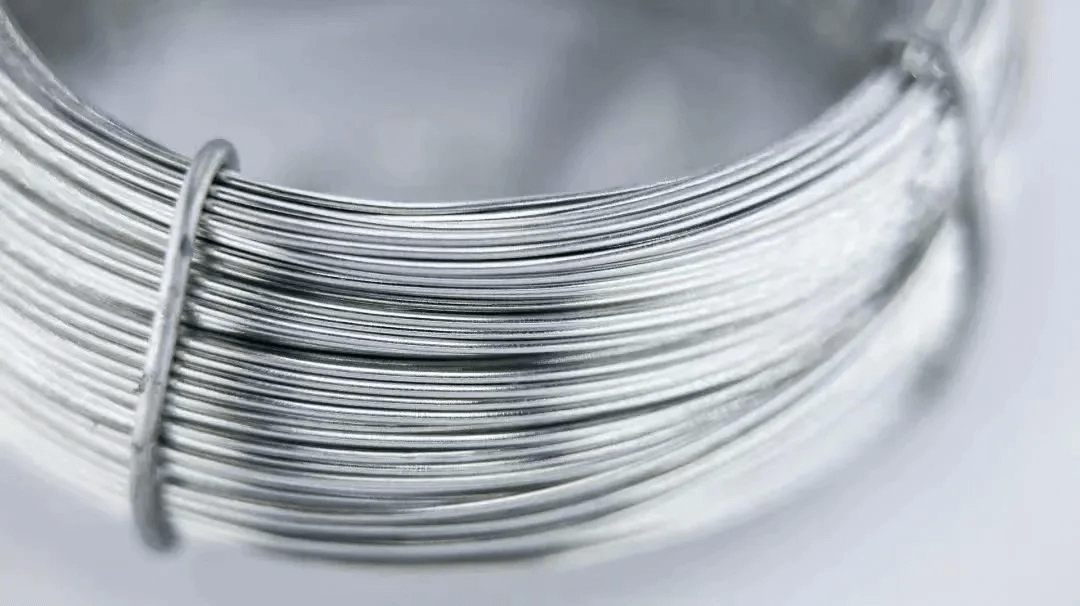
In view of the many advantages of aluminum wire, its application prospects are expected to continue to expand. However, we must note that traditional aluminum wires have certain deficiencies in conductor strength. Especially on small-sized wires such as 0.35mm² or 0.5mm², it is difficult for aluminum wires to reach the performance level of traditional copper wires. At the same time, for engine compartments that are subject to strong vibrations, the use of aluminum wires also faces certain challenges. Therefore, although the use of aluminum wire helps reduce the weight of the wiring harness, the degree of this reduction is limited. In practical applications, we need to comprehensively consider the performance and applicable scenarios of aluminum wires to achieve the best weight reduction effect.
Development of high-strength aluminum alloys
The development goal of small diameter aluminum conductors is to achieve an aluminum wire with a minimum size of 0.35mm2, which is the size of traditional copper wire. For automotive applications, wires need to have both high strength (tensile strength) and good electrical conductivity.
Sumitomo Electric has a deep understanding of the research on small diameter, high strength aluminum conductors.

For the research on small-diameter aluminum conductors, our ultimate goal is to ensure that the vibration resistance of small-diameter aluminum wires is equivalent to or less than that of traditional copper wires. Based on past data on terminal crimp strength, a target tensile strength of 220MPa and a conductivity of 50% IACS were set so that the fuse matching would not change even if one size was added to the conventional copper ISO wire.
Furthermore, for specific material properties we aim to meet official standards such as ISO.
Alloy design
Pure aluminum material for general industrial use (1060: purity 99.6%) has a high conductivity of 62% IACS, but a low tensile strength of only 70MPa. It is therefore necessary to increase the intensity of automotive applications.
This is when some reinforcing elements are added to the aluminum alloy used for conventional wires. However, this can only increase the strength to about 120MPa, which is about half the strength of conventional wire copper, and shrinking the wire to less than 0.75mm2 is difficult.
In the development of this new alloy, Sumitomo Electric compared the properties of various aluminum alloys and ultimately selected the 6000 series because its properties were closest to the target. Magnesium (Mg) and silicon (Si) are used as elements added to aluminum.
To determine the amount of Mg and Si additives, Sumitomo Electric cast the alloy material as a prototype and narrowed it down from alloy strength, conductivity and elongation, properties that affect the wire’s stretchability and ease of use.
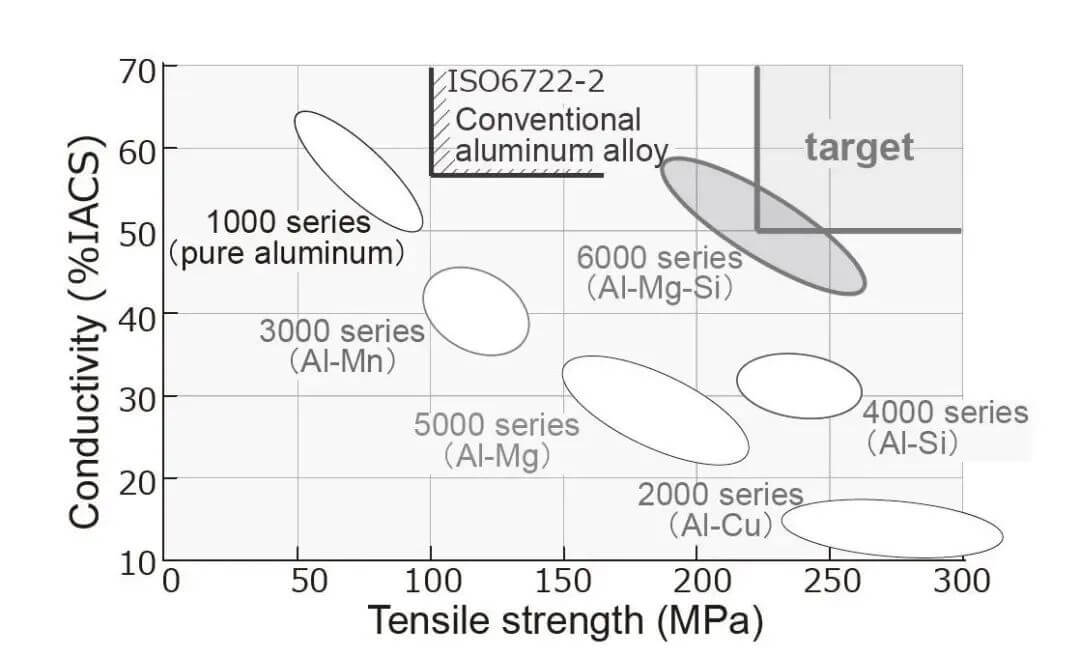
(Characteristics of various aluminum alloys)
Therefore, the range of target characteristics that can be satisfied is narrowed, as shown in the figure below. The additive amount that meets the target tensile strength of 220MPa and conductivity of 50% IACS was determined. Sumitomo Electric also considered refining methods, as described later, and further narrowed the scope to make production management easier. Therefore, we chose the alloy design value of Al-0.6mass%Mg-0.5mass%Si.
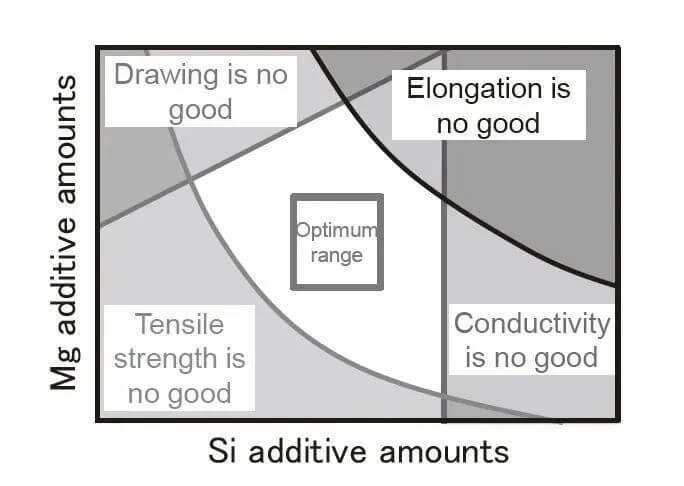
With this composition, Sumitomo Electric obtained an alloy with a tensile strength of 250 MPa and an electrical conductivity of 52% IACS, properties that exceeded the targets.
High strength aluminum wire structure
The table below shows the high-strength aluminum wire developed by Sumitomo Electric with a specification of 0.35mm2. The conductor has 19 0.155mm2 strands. Its flexible structure resists engine vibration. These characteristics make this aluminum wire comparable to traditional copper wire of the same specification. Weight can be reduced by 53%,
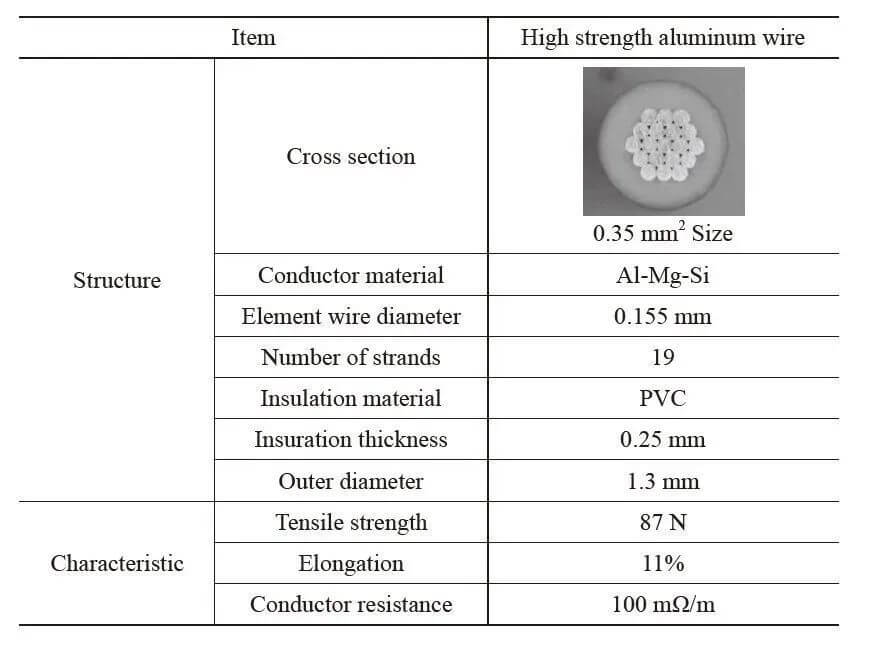
(High strength 0.35mm2 aluminum wire)
The figure below shows the S-N (strain amplitude and number of bending cycles) curves of high-strength aluminum alloys. Strain amplitude is the fluctuation in the rate of change of length of a surface conductor during bending.
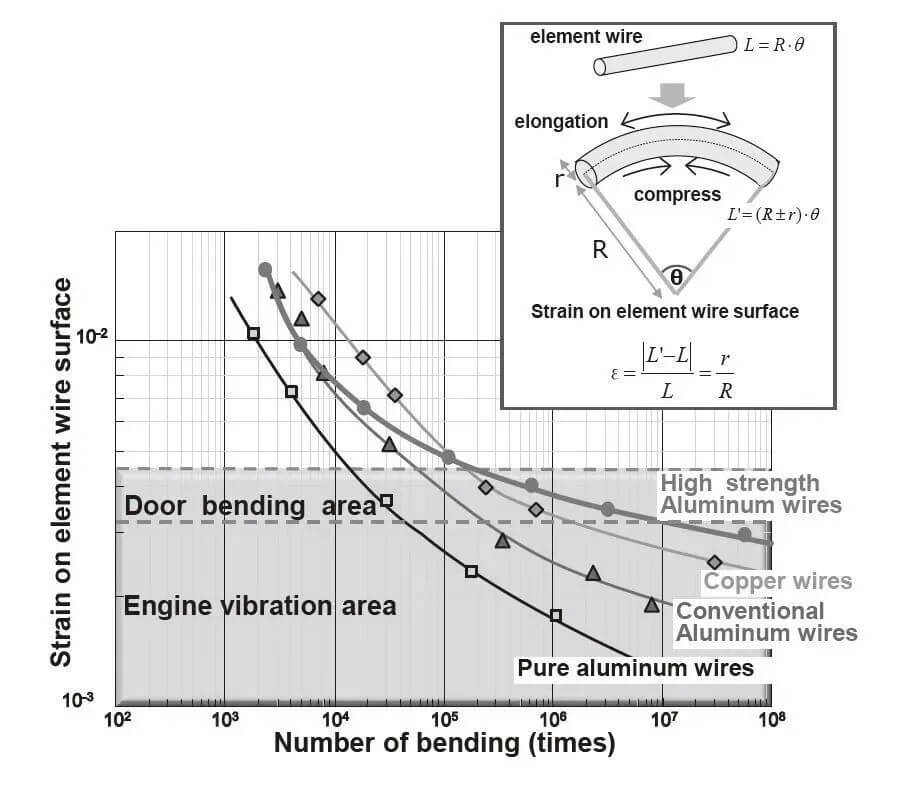
(S-N characteristics of various conductors)
The results show that the life of high-strength aluminum alloys at low strains is greatly improved compared with traditional aluminum alloys.
It also outperforms conventional copper wire in terms of engine vibration strain, which was the goal of this development. At low strains, the stronger the material, the longer its life, so we can say that this shows the effect of increasing the strength to higher values than copper.
High-strength aluminum alloys also exceed copper in bending tolerances for opening and closing doors. This can be described as the best conductor for bending tolerance and vibration tolerance.
Sumitomo Electric tested high-strength aluminum wire under conditions that simulated engine vibration, and the wire was actually used in the wiring harness.
In the results, good characteristics were obtained, as shown in the figure below. The strength of the developed wires was greatly improved compared to conventional aluminum wires, and it withstood more cycles than conventional copper wires.
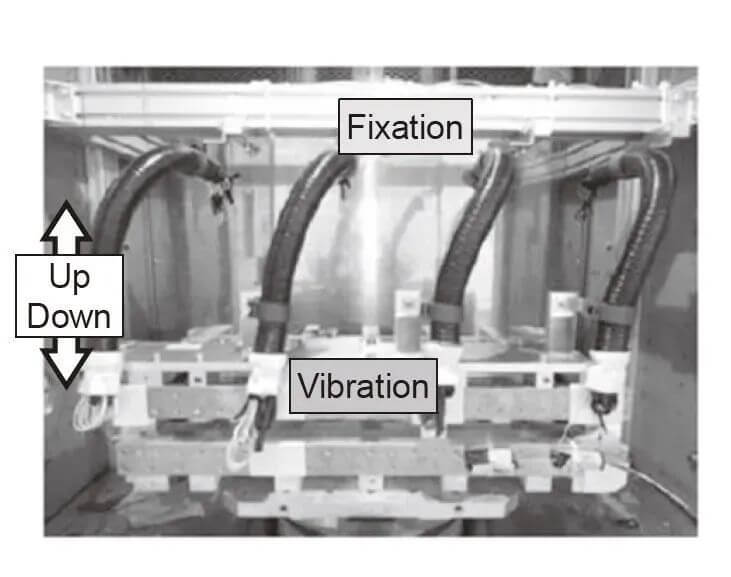
(Test conditions to simulate engine vibration)
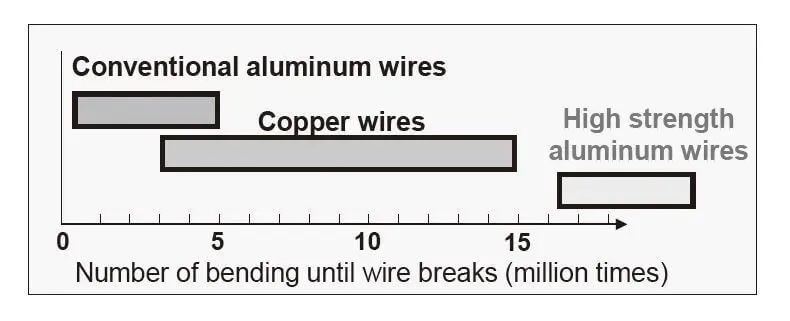
(Test results to simulate engine vibration)
Assuming the environment of an engine room, Sumitomo Electric studied the conductor strength during and after exposure to high temperatures of 125°C.
The developed aluminum alloy is stronger than traditional aluminum alloys. Although the strength decreases as the temperature increases, it is not lower than the strength of copper. Even at 125°C, the strength is higher than copper. Additionally, while strength decreased at room temperature, wires tested at 125°C maintained strength greater than copper.
In this way, high-strength aluminum wire ensures at least the same level of strength in the engine compartment as traditional copper wire.
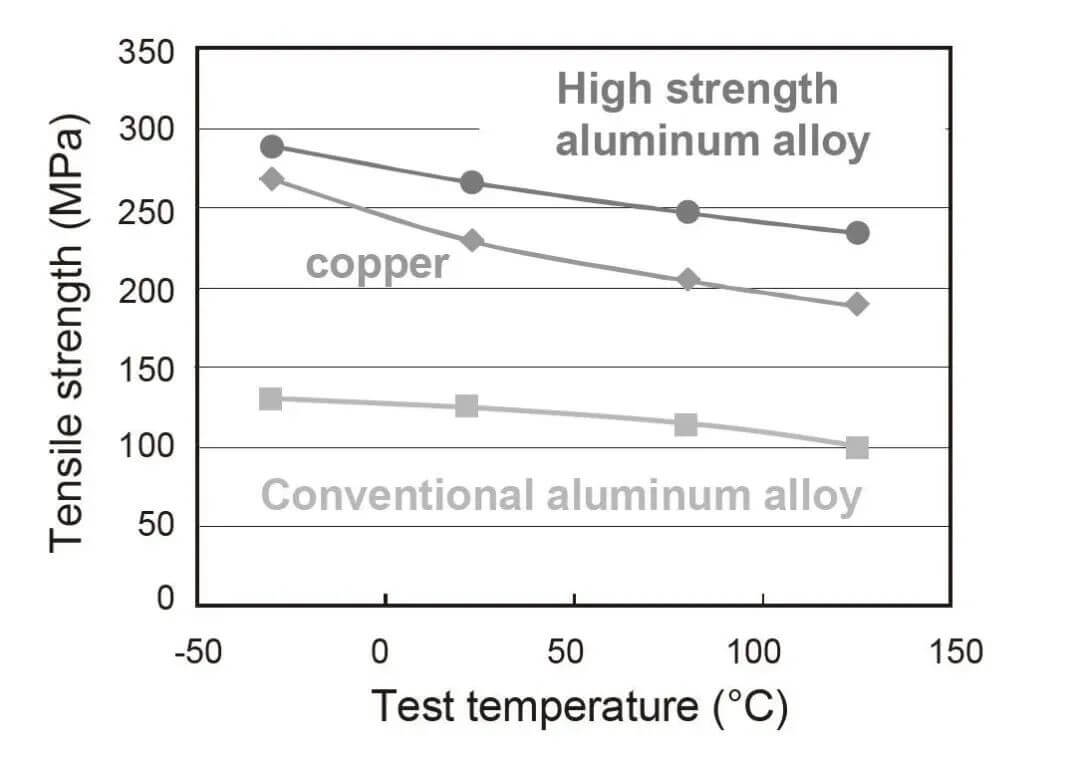
(Strength Temperature Characteristics)
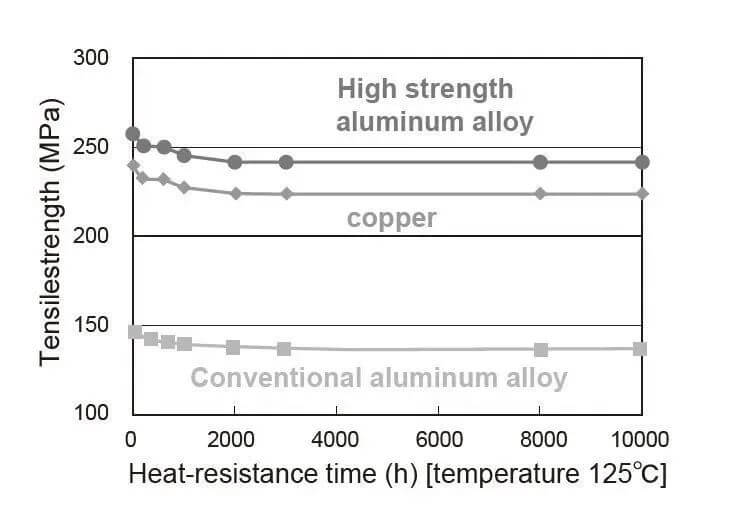
(Strength after high temperature storage)
Aluminum wire crimping
Sumitomo Electric’s crimping mode
Terminals are specific!
The structure usually used for the connection part of the automotive wiring harness is shown in the figure below. The terminal is attached to the wire using a method called crimping, and the terminal is then inserted and mated together into the connector.
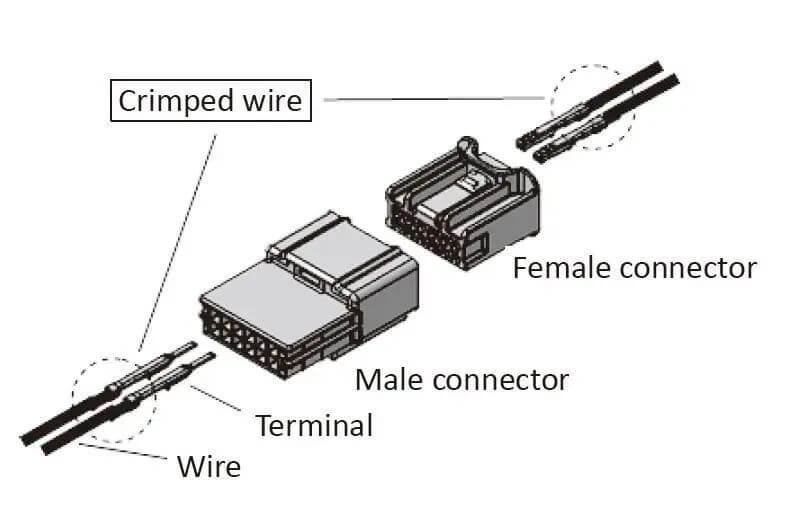
In order to expand the use of these aluminum wire harnesses, there is a need for terminals specifically designed for traditional aluminum wire that can be connected by crimping, which is common in wire harness manufacturing. This is a new crimping technology
Traditional crimping is a manufacturing method in which composite wire is stripped and squeezed with a U-shaped barrel on the terminal to obtain contact resistance and retention.

Since the surface of aluminum is covered with a strong insulating oxide film, it requires stronger extrusion than copper to obtain stable contact resistance. Sumitomo Electric studied the physical properties of high-strength aluminum wire conductors in terms of connection performance and verified whether the crimping method of conventional aluminum wires can also be used for the developed wires. The results are shown in the table below.

(Physical properties of wire conductors)
The study found that the physical properties of the oxide film on the developed wire are quite similar to those of traditional aluminum wire conductors. Since conventional crimping methods were likely to be used for the developed wires, Sumitomo Electric invented a new crimping mode. As shown in the figure below, the crimping conditions that meet the contact resistance and retention force standards are obtained.
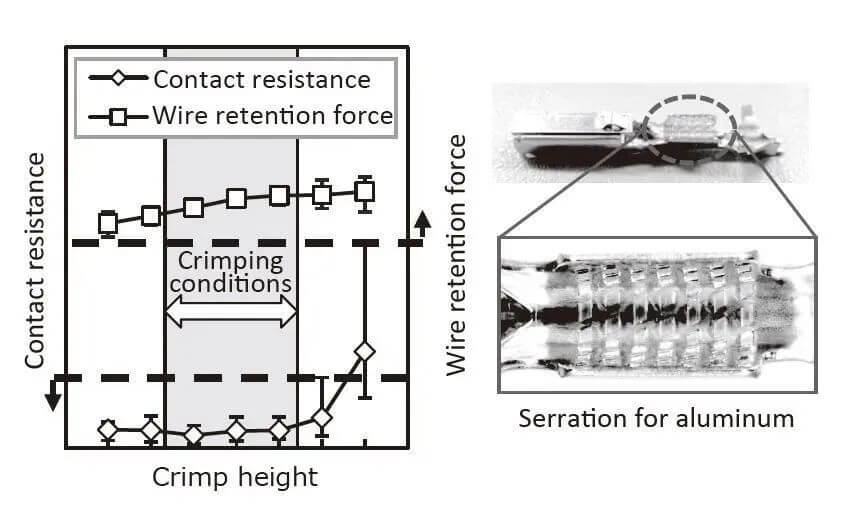
(Crimping characteristics of high-strength aluminum wire terminals)
It can be clearly seen that the structure of the terminal has many serrations.
TE Connectivity’s Aluminum Crimp Technology
Since 2009, TE has invented LITEALUM crimp technology to facilitate the reliable, durable crimping of aluminum stranded conductors of all cross-sections used in automotive applications.
This is similar to Sumitomo Electric’s crimping method.
TE’s newly developed solution for contacting aluminum conductors is the new LITEALUM crimp barrel. The design and surface properties of the F-shaped crimp barrel, especially the crimping area, are precisely tailored to the material requirements of the aluminum conductor.
The interior of the LITEALUM crimp barrel has sharp serrations that give the surface a “washboard” appearance. The term “shark fin serrations” adequately describes the contours of the ridged edges. During the crimping operation, the serrations break down the oxide layer, exposing the pure aluminum underneath, allowing electrical contact to be established through localized cold welding.
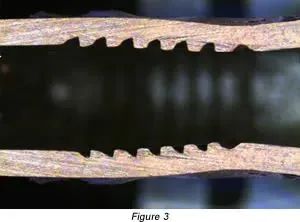
During the crimping process, the inherent ductility of aluminum is used in a targeted manner. The low yield point causes the conductor material to undergo greater mechanical deformation during the crimping process of the aluminum wire than does the copper sleeve. The volume flow caused by this deformation is axially displaced in two directions along the sharp ridges of the micro-serrations and enters them
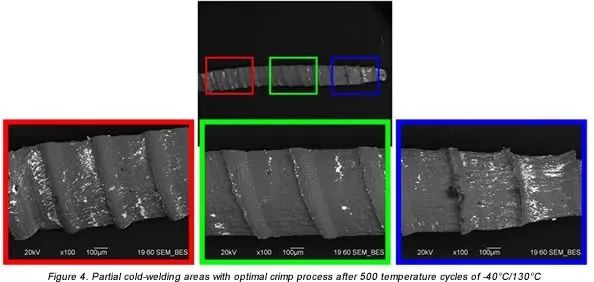
Oh, it turns out that specific terminals are required, and the terminal crimp sleeve needs to be serrated
Application of high-strength aluminum wire
It is interesting to use small diameter aluminum wire for engines!
Sumitomo Electric started manufacturing high-strength aluminum wires in April 2015, starting with 0.35mm2 wires.
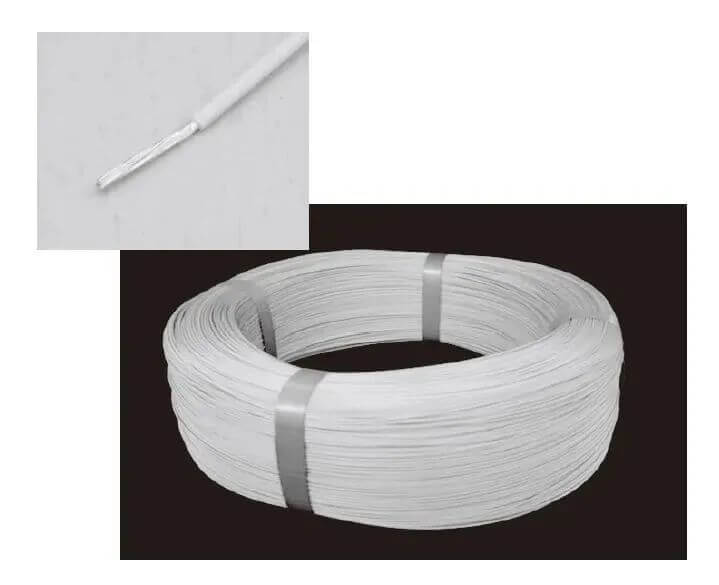
(0.35mm2 high strength aluminum wire)
High-strength aluminum wire produced by Sumitomo Electric accounts for 20% of the wire harness shown below.
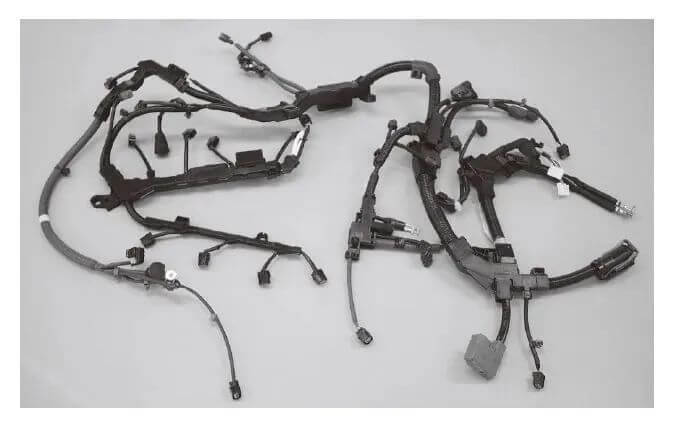
(Engine wiring harness using high-strength aluminum wire)
The table below shows the series of high-strength aluminum wires developed by Sumitomo Electric Industries.
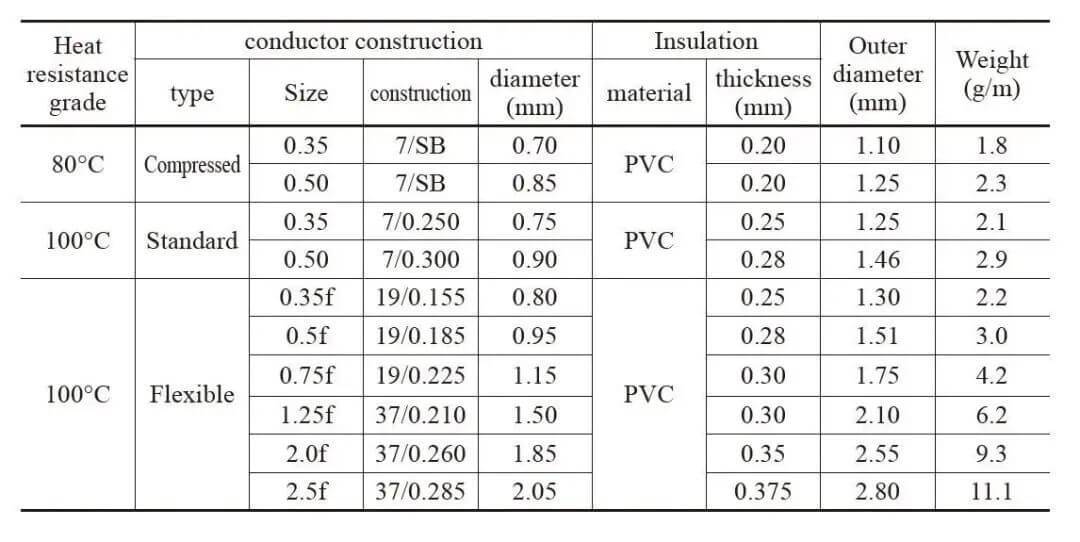
(Series of high-strength aluminum wire products)
Summarize
Aluminum wire is increasingly used in automobile manufacturing, especially in modern cars that have higher requirements for energy efficiency and environmental protection.
It should be noted that the application of aluminum wire in automobiles is not limited to the above-mentioned brands and models. With the advancement of technology and increasing environmental awareness, more and more automobile manufacturers are beginning to use aluminum wires to replace traditional copper wires to reduce vehicle weight, improve energy efficiency and environmental protection performance.
However, the application of aluminum wires in automobiles also faces some challenges, such as the connection problem between aluminum and copper and the high thermal expansion coefficient of aluminum wires. Therefore, car manufacturers need to continue to innovate and improve technology to overcome these challenges and promote wider application of aluminum wire in cars.
In short, the application of aluminum wire in automobile manufacturing is constantly increasing. In the future, with the advancement of technology and the improvement of environmental protection requirements, we can expect to see more car brands and models using aluminum wire.
